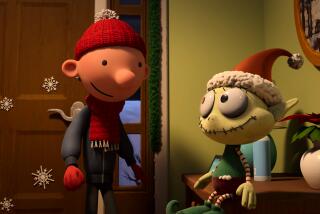Assorted gems for young readers: a roundup
Movie tie-ins are mostly pretty dull, but for the many fans of Jeff Kinney’s “Wimpy Kid” books, “The Wimpy Kid Movie Diary: How Greg Heffley Went to Hollywood” (Amulet Books/Abrams, $14.95, ages 8-12) may seem like another title in the series. Telling the story behind the film, which opened last weekend, it addresses objections like “Hey, that wasn’t in the book!” and discrepancies that kids, with their eye for detail, might notice.
Kinney explains the ins and outs of filmmaking with Greg Heffley-like comments: “You can’t always go back to the place where you shot the scene originally. So you have to fake it.” There are, of course, lots of stills from the film and the making of the film, and also lots of Kinney’s cartoons.
‘The Sky Is Everywhere’
In “The Sky Is Everywhere” (Dial: $17.99, ages 14 and up), Lennie Walker has spent her life being the invisible younger sidekick to her more outgoing sister, Bailey. When Bailey is killed in an accident, Lennie doesn’t know what to do with herself. To begin with, there is the fact that boys, no longer dazzled by Bailey’s presence, are suddenly noticing her. Soon, Lennie has two potential first loves -- the horn-playing new boy at school, whose talent and spectacular looks have overwhelmed the entire high school band while she was out mourning her sister, and her sister’s abandoned, grief-stricken boyfriend.
Sex and death are often connected, but author Jandy Nelson has cast the intensity of first love together with the intensity of grief to produce a novel that is unusually rich with both insight and breathless romance. She writes with abandon, setting her characters free to live their excesses, such as the hippie gardener whose flowers have magical properties, the best friend with a penchant for crazy animal metaphors and the inarticulate skateboarder whose pain finds only sexual expression. It’s a headlong sort of book, preferably devoured at a single sitting.
‘Stuck on Earth’
What’s the difference between a teenage boy and an alien? In “Stuck on Earth” (Farrar, Straus & Giroux: $16.99, ages 11-14), Ketchvar is a scientist sent from the planet Sandoval IV to assess the viability of Earth as a new home for the Lugonians, whose planet has become uninhabitable. To study humans, he is inserted into the brain of a randomly chosen 14-year-old male specimen.
Looking at Earth through alien eyes isn’t such a stretch for a teen male reader. The questions are obvious: Should humankind be annihilated? Why do moms say all those weird things? And here’s the big dilemma: Girls -- infernal torture device or a reason to forgive the world all its other shortcomings?
Ketchvar warns his superiors that it would be unwise to reveal the existence of the Galactic Confederation to humans: “Their limited intelligence, extreme egotism, xenophobia, and bellicose nature make any such direct contact impossible. Humans simply could not handle the information that they are a small and unimpressive race, nor do they have the wisdom and humility to accept our guidance.”
Although the conclusions of Ketchvar’s research won’t surprise anyone -- humans may be wretched creatures, but they are redeemed by Love, duh! -- the journey is entertaining, filled with laughs and shrewd observations about Homo sapiens.
‘Here Comes the Garbage Barge!’
In March 1987, a load of New York trash was shipped out from the refuse-glutted Long Island city of Islip, bound for a port in North Carolina; from there, it would be trucked into farm country and buried. Word got out, though, of this offensive and cumbersome method of dumping waste, and one community after another refused to let the infamous “garbage barge” dock. Jonah Winter’s “Here Comes the Garbage Barge!” (Schwartz & Wade Books/Random House: $17.99, ages 4-8) tells the story in wonderfully colorful language and inventive claymation-style illustrations. Each page is a diorama built from scratch, with clay people, and photographed to perfection.
As weeks pass, the garbage gets more and more disgusting, developing a slime that almost reeks on the page. Poor Cap’n Duffy, the skipper of the stinky barge, looks increasingly haggard as the voyage drags on. He tries a gas mask, then clamps a clothes-pin on his nose as he chugs past the Brooklyn Bridge on his way back to New York, which has been ordered to incinerate the mess. True to the book’s “reduce, reuse, recycle” message, not an inch of space is wasted. The whole process of making the art -- from storyboard to clay figures to three-dimensional scene -- is explained on the inside of the dust jacket! In case readers might have missed the moral, a buoy bobbing on the back endpaper announces: “Don’t make so much garbage!”
‘The Smash! Smash! Truck’
Yet another charming treatise on recycling, “The Smash! Smash! Truck” (David Fickling Books/Random House: $16.99, ages 5-8) connects the notion of sending glass back for reuse to the biggest, most mind-blowing scientific concept of all: the big bang. The matter that makes up our world, Aidan Potts points out, is constantly being recycled: “Atoms swirled together to form the Earth 4.5 billion years ago. Since then, very little has been added and almost nothing taken away.” All material is in constant motion, from the crust of the Earth to the cells of our body. “Atoms can’t be thrown away,” Potts writes, but by piling them up in plastic bags in landfills, “we can make them useless for a very long time.”
Bolle writes the Word Play column, which appears monthly at www.latimes .com/books.
More to Read
The biggest entertainment stories
Get our big stories about Hollywood, film, television, music, arts, culture and more right in your inbox as soon as they publish.
You may occasionally receive promotional content from the Los Angeles Times.






